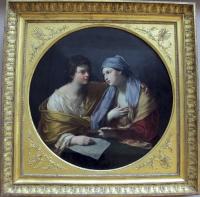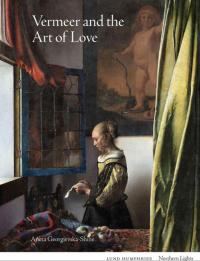Dr. Abigail McEwen contributes essay to 150th anniversary publication of Arts Student League (NYC)
Olga Albizu's training and work come to life in Dr. McEwen's essay


Research in art history and archaeology is an interdisciplinary enterprise.
We're here for Diversity, Equity, and Justice
Can a photograph capture a statue’s loss of meaning over time? Berenice Abbott’s 1936 photograph of Daniel Chester French’s Four Continents statues at the U.S. Custom House in New York asserts that it declares that it can.

This article offers a belated reading of Guido Reni's Union of Disegno and Colore. I argue that Reni's painting, though allegorical by nature, is a visual summary of his biography and artistic consciousness. Although the concept of compendio (compendium) is key to early modern Bolognese art historiography, it has yet to be analyzed closely, let alone applied to the many messages conveyed through Reni's Union. By interpreting the Union through biography, iconography, sex, and gender, I propose that we take seriously the concept of a visual compendium, one that gives form to Reni's ideal union of art.
Read More about Guido Reni's Compendio Disegno, Colore, and the Ideal Union of Art
Edited By Kirsten Strom
This book provides a conceptual and global overview of the field of Surrealist studies. Methodologically, the companion considers Surrealism’s many achievements, but also its historical shortcomings, to illuminate its connections to the historical and cultural moment(s) from which it originated and to assess both the ways in which it still shapes our world in inspiring ways and the ways in which it might appear problematic as we look back at it from a twenty-first-century vantage point. Contributions from experienced scholars will enable professors to teach the subject more broadly, by opening their eyes to aspects of the field that are on the margins of their expertise, and it will enable scholars to identify new areas of study in their own work, by indicating lines of research at a tangent to their own.
The companion will reflect the interdisciplinarity of Surrealism by incorporating discussions pertaining to the visual arts, as well as literature, film, and political and intellectual history.
Votvie banquet reliefs featuring a reclining elder male employed a visual language that to ancient viewers unambiguously defined the nature and identity of a hero. This highly flexible language appears to have been quickly adopted in the heroising realm of funerary monuments by the end of the Late Classical period, circa 400-323 BCE, and remained a desired aesthetic throughout the Hellenistic period, circa 323-33 BCE. In this lesser known and smaller corpus of votive banquet reliefs, few examples retain any vestiges of polychromy or inscriptions. An unstudied and unpublished relief of this type from the Memphis Brooks Museum of Art, however, exceptionally retains both. A close study of this relief provides insight into the aesthetic tastes of the Late Classical period, as well as an understanding of how banqueting iconography, originally reserved for a hero rather than heroised deceased, was emphatically adopted into the funerary sphere at the end of the fourth century BCE.
Britta Jackson
Claire Roberts
Huang Binhong (1865-1955), a key twentieth-century artist and art historian, produced distinctive floral works and the rare figure painting but focused intently on landscapes. Influenced by early masters, he also studied nature directly. Near the end of his life, despite seriously compromised eyesight, he used rich and dark “burnt” ink to create sublime masterpieces that bridge representation and abstraction. Modern Ink: The Art of Huang Binhong will demonstrate how nature, art historical erudition, a finely tuned compositional sense, and an appreciation for rich and even tonality—derived from epigraphic rubbings—come together in this consummate painter’s late, great landscapes. It will also examine his work in other genres as well as the role of his extraordinary vision as a major force behind the persistence of traditional values in contemporary Chinese ink art.
The book is the fourth volume in the book series Modern Ink.

Vermeer and the Art of Love deals with private emotions evoked in domestic interiors in which a young woman may be writing a letter to her absent beloved or playing a virginal in the presence of an admirer. But it is also about the love we sense in the painter’s attentiveness to every detail within those rooms, which lends even the most mundane of objects the quality of something extraordinary. In this engaging book, the author uncovers the ways in which Vermeer challenges the dichotomies between 'good' and 'bad' love, the sensual and the spiritual, placing him within the context of his contemporaries, as well as within the broader discourse on love and art in early modern Europe.
Surveys the representations and constructions of the human being in American art.
Humans are organisms, but “the human being” is a term referring to a complicated, self-contradictory, and historically evolving set of concepts and practices. Humans explores competing versions, constructs, and ideas of the human being that have figured prominently in the arts of the United States. These essays consider a range of artworks from the colonial period to the present, examining how they have reflected, shaped, and modeled ideas of the human in American culture and politics. The book addresses to what extent artworks have conferred more humanity on some human beings than others, how art has shaped ideas about the relationships between humans and other beings and things, and in what ways different artistic constructions of the human being evolved, clashed, and intermingled over the course of American history. Humans both tells the history of a concept foundational to US civilization and proposes new means for its urgently needed rethinking.
Entries on Hamish Fulton, Chryssa, Jimmie Durham, Joseph Cornell, and Paul Gauguin in Hirshhorn Museum and Sculpture Garden: The Collection. edited by Stéphane Aquin and Anne Reeve. New York: Delmonico Books, 2022
Marco Polo Juárez Cruz & Gabrielle Tillenburg
Re•Cast is organized by UMD Department of Art History and Archaeology Graduate Students Marco Polo Juárez Cruz, Cléa Massiani, and Gabrielle Tillenburg, under the direction of Associate Professor Abigail McEwen.
This essay addresses Rubens’s perspective on the human/animal relationship as exemplified by the figure of the satyr. As the author argues, in addition to established associations with ideas of unbridled sensuality, this liminal character relates to deeper philosophical considerations about the interconnectedness of all living beings. Furthermore, a closer look at the connection between the satyr and the literary satire demonstrates that Rubens’s satiric images bear a number of salient qualities of this genre as one that destabilizes all boundaries: be it between the beautiful and the repulsive, the tragic and the comical, or the sublime and the grotesque.